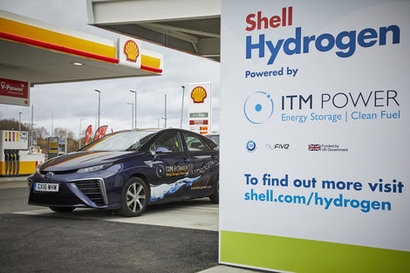
ITM Power has developed a rapid response, high pressure electrolyser product platform that is scalable from 0.5 to 100 MW applications, converting surplus renewable energy via the splitting of water into its components hydrogen and oxygen. The green hydrogen produced via this process could be used for a number of industrial sectors, including transport, chemicals, steel, plastic, power, heat and fertiliser. Last week, the company announced it would be supplying the electrolyser to Shell in order to generate hydrogen for their refinery in Germany. In the same week, it also announced that it will be supplying the first hydrogen bus refuelling station in France.
The use of electrolysis for energy storage, known as Power-to-Gas, can significantly increase the flexibility of the electrical network that will be needed to integrate a large level of renewable power sources into the energy system. Hydrogen is potentially one of the best approaches to massive storage of electricity, from periods of several days to long-term seasonal storage, thus solving the storage problems currently being experienced with the introduction of large levels of renewable energy.
“Renewable energy supplies are regularly turned off when they exceed demand; it’s called ‘curtailment’” said Dr. Graham Cooley, CEO of ITM Power. “But ITM Power’s systems can harness and fully utilise this surplus renewable energy to create hydrogen. This can be done anywhere there is an electricity and water supply, eliminating the need for deliveries by road and using electricity at times when the price is lowest.”
The new UK Government Air Quality Plan that bans all new nonzero emission passenger cars by 2040 represents an historic first step towards cleaner and greener transport in the UK, one in which hydrogen will play a large part. Hydrogen as a fuel for Fuel Cell Electric Vehicles (FCEVs) cars, buses, trains and ferries is a very attractive option. FCEV cars are able to refuel in three minutes, offer a 320-mile range, with the only emission being water vapour.
ITM Power currently has four publically available hydrogen stations in the UK, and one in California. This will increase to 10 stations in the UK by the end of next year. It is an attractive solution to fuel providers as the hydrogen can be made in a very green way, using excess renewables and water, generating on site, which eliminates the requirement for fuel deliveries.
The electrolyser technology has now been deployed in both Power-to-Gas and Clean Fuel applications and ITM Power claims the technology can be scaled to 100 MW. The electrolyser benefits from ITM Power’s Proton Exchange Membrane (PEM) technology and system design philosophy, thereby offering numerous advantages compared to existing technology. These include a small footprint with regard to siting the technology and high system efficiency, which in turn lowers costs. It can also offer an ultra-rapid response and, as a modular system, can be expanded so that deployment can be phased in, allowing users to expand capacity in step with demand, thereby avoiding the risk of under-utilised plants.
In Germany, the Thüga Group and RWE WestNet are using ITM Power electrolysers already, as a direct transducer between the power and gas networks in Germany. The hydrogen generated is injected into the gas network, blending with natural gas and reducing the carbon footprint of everything downstream. In the UK, ITM Power is also working together with Northern Gas Networks and National Grid to pilot Power-to-Gas at Keele with a £7 million project called HyDeploy.
The use of electrolysis for the on-site generation of hydrogen fuel carries all of the benefits of Power-to-Gas, as well as supporting rollout of sustainable hydrogen refuelling infrastructure. The European Commission has identified hydrogen-fuelled fuel cell electric vehicles (FCEVs) as one of the technologies required for Europe to meet its ambitious energy security objectives while eliminating air pollution and delivering a minimum 60 percent reduction of greenhouse gas (GHG) emissions from transport by 2050.
Image: ITM Power hydrogen station at Shell service station in Cobham, UK
For additional information:

